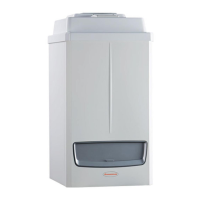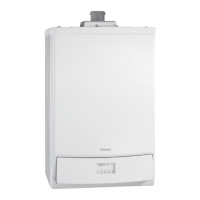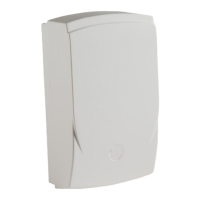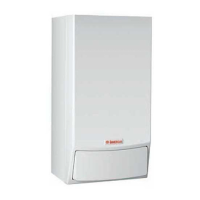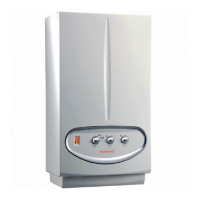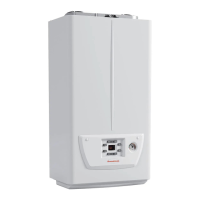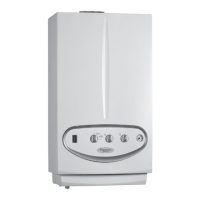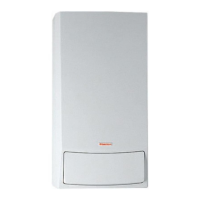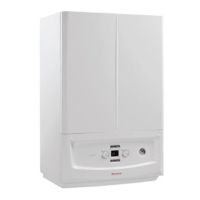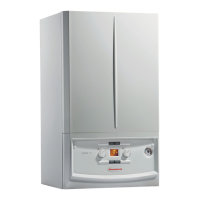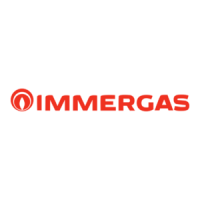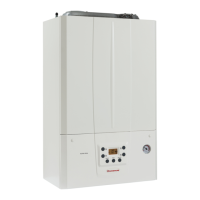39
INSTALLERUSERTECHNICIAN
3.6 Converting the boiler to another type of gas.
If the boiler has to be converted to a dierent gas type to that
specied on the dataplate, request the relative conversion kit
for quick and easy conversion.
Boiler conversion must be carried out by a qualied techni-
cian (e.g. Immergas Technical Assistance Service).
To convert to another type of gas the following operations
are required:
- replace the nozzle located between the gas pipe and gas/air
mixing sleeve (detail 7 page 20);
- adjust maximum boiler heat output by changing the fan
rpm (parameter 13 page 35);
- check the value of CO
2
in fumes at max. power with respect
to the table given on page 40;
- check the value of CO
2
in fumes at min. power with respect
to the table given on page 40;
- seal the gas flow regulation devices (if settings are
changed);
- after completing conversion, apply the sticker, present in
the conversion kit, near the dataplate. Using an indelible
marker pen, cancel the data relative to the old type of
gas.
ese adjustments must be made with reference to the type
of gas used.
3.7 Checks following conversion to another type of
gas.
After making sure that conversion was carried out with a
nozzle of suitable diameter for the type of gas used and the
settings are made at the correct pressure, check that:
- the burner ame is not too high or low and is stable (does
not detach from burner);
- the pressure testers used for calibration are perfectly closed
and there are no leaks in the gas circuit.
N.B.: All boiler adjustment operations must be carried out by
a qualied technician (e.g. Immergas Assistance Service).
Burner adjustment must be carried out using a dierential
digital type pressure gauge (with scale in tenths of mm or
Pascal), connected to the gas valve (P3 - P2) outlet pressure
point and on the pressure tester located above the sealed
chamber (detail 15 page 20), respecting the pressure value
given in the table on page 43 according to the type of gas
for which the boiler is arranged.
3.8 Possible adjustments.
• Rated heat output check.
e boiler rated heat output is correlated to the length of
the air intake and fume exhaust pipes. It decreases slightly in
proportion to the increase in pipe length, therefore in case of
max. pipe extension it is necessary to check the “∆p” values at
the ends of the Venturi and gas pressure at the nozzle after at
least 5 minutes of burner operation, when the air intake and
exhaust gas temperatures have stabilized. If necessary, modify
the values of parameter No. 13 “Fan max. rpm in heating”.
Use dierential manometers connected to the “∆p” pressure
points on the Venturi and nozzle gas pressure as specied in
the chapter “Air/gas ratio adjustment”.
is adjustment is not necessary during the initial check, as
the boiler is factory-set with the correct air/gas ratio.
However, it may be necessary during extraordinary main-
tenance, with replacement of air and gas circuit compo-
nents.
After any adjustments:
- ensure that the pressure testers used for calibration are
perfectly closed and there are no leaks in the gas circuit;
- seal the gas ow regulation devices (if settings are modi-
ed).
3.9 Air/gas ratio adjustment.
Min. CO
2
setting.
Switch the boiler on and run it at min. heat output pressing
the “MODE” and “-” keys at the same time for 2 seconds;
in this way the boiler is forced to minimum and the display
shows the letter “L” followed by a 2-digit number. To have
an exact value of CO
2
in the fumes the technician must insert
the sampling probe to the bottom of the chamber, then check
that the CO
2
value is that specied in the table on page 40,
otherwise adjust the screw (3 page 41) (O-Set regulator).
Max. CO
2
setting.
After min. CO
2
adjustment, switch the boiler on and bring
it to “chimney-sweep” phase pressing the “MODE” and “+”
keys at the same time for 2 seconds; in this way the boiler
is forced to maximum and the display shows the letter “H”
followed by a 2-digit number. To have an exact value of CO
2
in the fumes the technician must insert the sampling probe
to the bottom of the chamber, then check that the CO
2
value
is that specied in the table on page 40, otherwise adjust the
screw (12 page 41) (gas ow regulator).
To increase the CO
2
value turn the adjustment screw (12)
anticlockwise or clockwise to decrease the value.
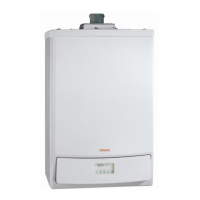
